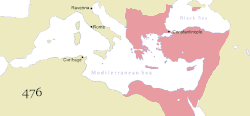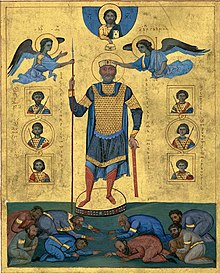Byzantine Empire under the Macedonian dynasty
Byzantine Empire
| |||||||||||||||||
|---|---|---|---|---|---|---|---|---|---|---|---|---|---|---|---|---|---|
• 867–886 | Basil I | ||||||||||||||||
• 1055–1056 | Theodora Porphyrogenita | ||||||||||||||||
| History | |||||||||||||||||
• Murder of Michael III | 24 September 867 | ||||||||||||||||
• Death of Theodora Porphyrogenita | 31 August 1056 | ||||||||||||||||
| |||||||||||||||||
| History of the Byzantine Empire |
|---|
 |
| Preceding |
|
| Early period (330–717) |
|
| Middle period (717–1204) |
| Late period (1204–1453) |
| Timeline |
| By topic |
|
|
The Byzantine Empire under the Macedonian dynasty underwent a revival during the late 9th, 10th, and early 11th centuries. Under the
The cities of the empire expanded, and affluence spread across the provinces because of the newfound security. The population rose, and production increased, stimulating new demand for trade.
Culturally, there was considerable growth in education and learning (the "Macedonian Renaissance"). Ancient texts were preserved and recopied. Byzantine art flourished, and brilliant mosaics graced the interiors of the many new churches.[2]
Though the empire was much smaller than during the reign of Justinian, it was stronger, as its territories were both less dispersed and more politically and culturally integrated.[citation needed]
Internal developments
Although tradition attributed the "Byzantine Renaissance" to Basil I (867–886), initiator of the Macedonian dynasty, some later scholars have credited the reforms of Basil's predecessor, Michael III (842–867) and of the erudite Theoktistos (died 855). The latter in particular favoured culture at the court, and, with a careful financial policy, steadily increased gold reserves. The rise of the Macedonian dynasty coincided with developments that strengthened the religious unity of the empire.[3]
The
Wars against the Muslims

By 867, the empire had stabilized its position in both the east and the west, while the success of its defensive military structure had enabled the emperors to begin planning wars of reconquest in the east.
The process of reconquest began with variable fortunes. The temporary reconquest of Crete (843) was followed by a crushing Byzantine defeat on the Bosporus, while the emperors were unable to prevent the ongoing Muslim conquest of Sicily (827–902). Using present-day Tunisia as their launching pad, the Muslims conquered Palermo in 831, Messina in 842, Enna in 859, Syracuse in 878, Catania in 900 and the final Greek stronghold, the fortress of Taormina, in 902.
These drawbacks were later counterbalanced by a victorious expedition against
The threat from the
In 904, disaster struck the empire when its second city,
The situation on the border with the Arab territories remained fluid, with the Byzantines alternatively on the offensive or defensive.
The soldier emperors
Wars against Bulgaria

The traditional struggle with the
A great imperial expedition under
Under the emperor
During this period the Byzantine princess
Relations with Kievan Rus'
Between 800 and 1100, the empire developed a mixed relationship with the new state of Kievan Rus' that emerged to the north across the Black Sea.
The Byzantine Empire quickly became the main trading and cultural partner for Kiev. After Christianizing, Rus' Vladimir the Great employed many architects and artists to work on numerous cathedrals and churches around Rus', expanding the Byzantine influence even further.
Kievan Rus' princes were often married into the Byzantine imperial family and Constantinople often employed princes' armies; most notably, Vladimir the Great presented Byzantium with the famous Varangian Guard – an army of vicious Scandinavian mercenaries. Some believe that this was in exchange for the marriage of Basil's sister Anna to Vladimir.[2] However, the Primary Chronicle states the marriage was in exchange for the Rus' conversion to orthodoxy; the Varangian Guard was a by-product (although a significant one) of this exchange.
The relationship was not always friendly. During this three-hundred-year interval Constantinople and other Byzantine cities were attacked several times by the armies of Kievan Rus' (see Rus'-Byzantine Wars). Kiev never went far enough to actually endanger the empire; the wars were primarily a tool to force the Byzantines to sign increasingly favorable trade treaties, the texts of which are recorded in the Primary Chronicle (Rus'–Byzantine Treaty (907))[5] and other historical documents. Constantinople at the same time constantly pitted Kievan Rus', Bulgaria, and Poland against each other.
The Byzantine influence on Kievan Rus' cannot be overstated. Byzantine-style writing became a standard for the adopted from
Triumph

The Byzantine Empire now stretched to Armenia in the east, to Calabria in Southern Italy in the west.[2] Many successes had been achieved, ranging from the conquest of Bulgaria, to the annexation of parts of Georgia and Armenia, to the total annihilation of an invading force of Egyptians outside Antioch. Yet even these victories were not enough; Basil considered the continued Arab occupation of Sicily to be an outrage. Accordingly, he planned to reconquer the island, which had belonged to the empire for over three hundred years (c. 535 – c. 902). However, his death in 1025 put an end to the project.[2]
The 11th century was also momentous for its religious events. In 1054, relations between Greek and Slavic-speaking Eastern and Latin-speaking Western Christian traditions reached a terminal crisis. Although there was a formal declaration of institutional separation, on July 16, when three papal legates entered the
See also
- Macedonian dynasty and related family tree
- Family trees of the Byzantine imperial dynasties
- Lekapenos
- Phokas (Byzantine family)
References
- ISBN 978-0-8132-0754-4.
- ^ ISBN 0-14-025960-0.
- ^ Лаврентьевская летопись [Códice de Laurencio] (in Russian). Vol. 1. Colección completa de Crónicas de Rusia. pp. 95–102.
- ISBN 0-582-29468-1.
- ^ Prince Oleg's Campaign Against Constantinople
